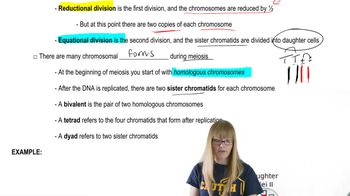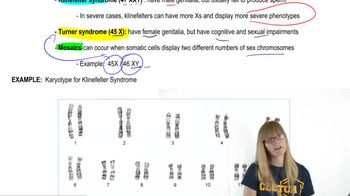Wolves and coyotes can interbreed in captivity, and now, because of changes in their habitat distribution, they may have the opportunity to interbreed in the wild. To examine this possibility, mitochondrial DNA from wolf and coyote populations throughout North America—including habitats where the two species both reside—was analyzed, and a phylogenetic tree was constructed from the resulting data. A sequence from a jackal was used as an outgroup, and a sequence from a domestic dog was included, demonstrating wolves as the origin of domestic dogs. What do you conclude about the possibility that interspecific hybridization occurred between wolves and coyotes on the basis of this phylogenetic tree?
Table of contents
- 1. Introduction to Genetics51m
- 2. Mendel's Laws of Inheritance3h 37m
- 3. Extensions to Mendelian Inheritance2h 41m
- 4. Genetic Mapping and Linkage2h 28m
- 5. Genetics of Bacteria and Viruses1h 21m
- 6. Chromosomal Variation1h 48m
- 7. DNA and Chromosome Structure56m
- 8. DNA Replication1h 10m
- 9. Mitosis and Meiosis1h 34m
- 10. Transcription1h 0m
- 11. Translation58m
- 12. Gene Regulation in Prokaryotes1h 19m
- 13. Gene Regulation in Eukaryotes44m
- 14. Genetic Control of Development44m
- 15. Genomes and Genomics1h 50m
- 16. Transposable Elements47m
- 17. Mutation, Repair, and Recombination1h 6m
- 18. Molecular Genetic Tools19m
- 19. Cancer Genetics29m
- 20. Quantitative Genetics1h 26m
- 21. Population Genetics50m
- 22. Evolutionary Genetics29m
9. Mitosis and Meiosis
Development of Animal Gametes
Problem 34
Textbook Question
Kuliev and Verlinsky (2004) state that there was a relatively high number of separation errors at meiosis I. In these cases the centromere underwent a premature division, occurring at meiosis I rather than meiosis II. Regarding chromosome 21, what would you expect to be the chromosome 21 complement in the secondary oocyte in which you saw a single chromatid (monad) for chromosome 21 in the first polar body? If this secondary oocyte was involved in fertilization, what would be the expected consequences?
 Verified step by step guidance
Verified step by step guidance1
Understand the context: The problem involves errors during meiosis I, specifically premature separation of sister chromatids. Normally, homologous chromosomes separate during meiosis I, and sister chromatids separate during meiosis II. However, in this case, the centromere prematurely divides during meiosis I, leading to abnormal chromosome segregation.
Analyze the chromosome 21 complement in the secondary oocyte: If a single chromatid (monad) for chromosome 21 is observed in the first polar body, it means that one of the sister chromatids of chromosome 21 was segregated into the first polar body during meiosis I. This indicates that the secondary oocyte will have the other sister chromatid of chromosome 21, resulting in a single chromatid (monad) for chromosome 21 in the secondary oocyte.
Consider the consequences of fertilization: During fertilization, the secondary oocyte will combine with a normal haploid sperm, which contributes one full chromosome 21. Since the secondary oocyte contains only a single chromatid for chromosome 21, the resulting zygote will have an abnormal chromosome 21 complement.
Predict the zygote's chromosome 21 complement: The zygote will have one full chromosome 21 from the sperm and only a single chromatid (monad) from the oocyte. This results in an imbalance in the chromosome 21 complement, which could lead to developmental abnormalities or non-viability.
Summarize the expected consequences: The abnormal chromosome 21 complement in the zygote could lead to genetic disorders or developmental issues. For example, if the zygote ends up with a monosomy (only one copy of chromosome 21), it is typically lethal. Alternatively, if the chromatid duplicates post-fertilization, it could lead to mosaicism or other chromosomal abnormalities.
 Verified video answer for a similar problem:
Verified video answer for a similar problem:This video solution was recommended by our tutors as helpful for the problem above
Video duration:
1mPlay a video:
Was this helpful?
Key Concepts
Here are the essential concepts you must grasp in order to answer the question correctly.
Meiosis and Chromosome Segregation
Meiosis is a specialized form of cell division that reduces the chromosome number by half, resulting in four haploid cells. During meiosis I, homologous chromosomes are separated, while meiosis II separates sister chromatids. Errors in this process, such as premature centromere division, can lead to aneuploidy, where gametes have an abnormal number of chromosomes.
Recommended video:
Guided course

Meiosis Overview
Chromosome 21 and Down Syndrome
Chromosome 21 is one of the smallest human chromosomes and is associated with Down syndrome when there is an extra copy (trisomy 21). If a secondary oocyte has a single chromatid for chromosome 21, it indicates that one chromatid was retained while the other was segregated into the first polar body. This can lead to fertilization with an abnormal chromosome complement, potentially resulting in Down syndrome.
Recommended video:
Guided course

Human Sex Chromosomes
Polar Bodies and Oocyte Development
Polar bodies are small cells produced during oocyte development that typically do not develop into ova. They are a byproduct of meiosis, allowing the oocyte to retain most of the cytoplasm and genetic material. The presence of a single chromatid in the first polar body suggests that the secondary oocyte may have an abnormal chromosomal arrangement, which can affect the genetic outcome of fertilization.
Recommended video:
Guided course

Gamete Development
Related Videos
Related Practice
Textbook Question
357
views


